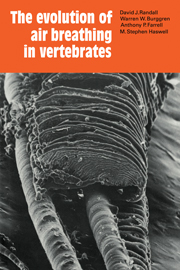Book contents
- Frontmatter
- Contents
- Preface
- 1 Introduction: air breathing in vertebrates
- 2 Gas transfer: the transition from water to air breathing
- 3 Ventilation and perfusion relationships
- 4 Mechanisms of ventilation
- 5 Regulation and control of gas transfer
- 6 The evolution of air breathing: a synthesis and summary
- References
- Index
5 - Regulation and control of gas transfer
Published online by Cambridge University Press: 01 March 2011
- Frontmatter
- Contents
- Preface
- 1 Introduction: air breathing in vertebrates
- 2 Gas transfer: the transition from water to air breathing
- 3 Ventilation and perfusion relationships
- 4 Mechanisms of ventilation
- 5 Regulation and control of gas transfer
- 6 The evolution of air breathing: a synthesis and summary
- References
- Index
Summary
Common to all terrestrial air breathers and their bimodal and aquatic antecedents is the need to achieve a balance between O2 consumption–CO2 excretion in the tissues and the rate of delivery or removal of these gases via the gills, bladder, skin, or lungs. This balance between “supply” and “demand” normally is very finely controlled in some groups of vertebrates, whereas in others it may be achieved only in the relatively long term.
Continuous water breathers
Almost all water breathers respond to hypoxic exposure with an increase in the frequency and amplitude of branchial pumping (see Shelton 1970b for review). The extraction of O2 from the water in aquatic breathers is usually low, but the oxygen stores of the body, intervening between the respiratory membranes and the mitochondria, are limited to comparatively small amounts bound to hemoglobin and myoglobin. Thus, overall there is not a high oxygen-store-to-oxygen-utilization ratio (Chapter 3), a situation that severely restricts the short-term ability of aquatic fish to protect the tissues from the effects of environmental hypoxia or changes in metabolic rate. This low store-to-utilization ratio has necessitated a sensitive control over both ventilation and perfusion to maintain oxygen supplies to the tissues. Such a control system has to (1) provide monitoring of respiratory gas levels, particularly O2, at one or more sites between the respiratory membranes and the mitochondria, and (2) mediate active behavioral (avoidance) and physiological (hyperventilation, lamellar recruitment) responses, such that even brief imbalances in O2 supply and demand are obviated.
- Type
- Chapter
- Information
- The Evolution of Air Breathing in Vertebrates , pp. 106 - 114Publisher: Cambridge University PressPrint publication year: 1981



